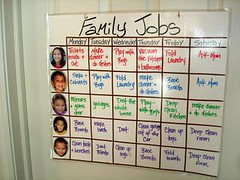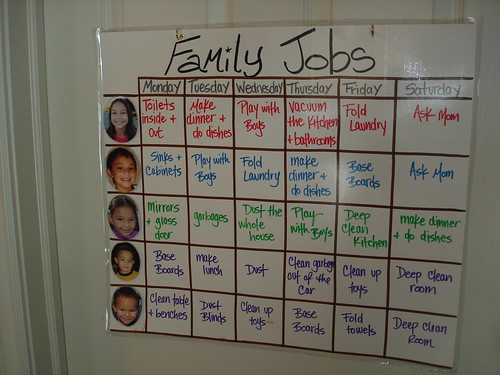This is a great post for leaders and parents that I got from www.shmula.com
Visual Management and Self-Reliance
 One of my primary goals in life is to teach my kids to be eventually good, productive, and self-reliant adults. One area of life-skills that my wife and I are focused on in teaching our children, is teaching them the principle of work: how to work, the value of work, to take ownership over their responsibilities, and to be proud of their accomplishments, and to learn to work as a team and family. One way we are reinforcing the principle of work is through the use of effective Visual Management.
One of my primary goals in life is to teach my kids to be eventually good, productive, and self-reliant adults. One area of life-skills that my wife and I are focused on in teaching our children, is teaching them the principle of work: how to work, the value of work, to take ownership over their responsibilities, and to be proud of their accomplishments, and to learn to work as a team and family. One way we are reinforcing the principle of work is through the use of effective Visual Management.
Visual Management has the following purposes:
- Visual Management provides instruction
- Visual Management conveys information
- Visual Management provides immediate feedback
- Visual Management quickly exposes abnormalities in a process or work area
- Visual Management quickly conveys progress or lack thereof
My wife created a wonderful job chart, which you find below:

This Job Chart is in our kitchen, where there is frequent foot traffic and where our family spends most of our time. There are a few items I’d like to note:
- My kid’s ages are (from top-to-bottom): 9,8,7,3,3
- The Kid’s Heads: Visually representing each child with their face is much more effective than using their names. The Kid’s Heads are laminated and have Velcro on the back, to facilitate ease-of-job-rotation. This approach is also very environmentally friendly, since the pictures and the board are laminated — there’s no waste.
- We have jobs over 6 days — Monday through Saturday and the jobs are fixed, but the heads are rotateable. The younger boys (the twins) rotate with each other at the bottom 2 rows — those jobs are designed for their age and ability. The top-3 rows contain jobs for the older kids and those jobs are designed for their age and ability.
- Every Sunday, we rotate the heads for the upcoming week.
Deploying The Program
When my wife and I first met about this during our end-of-the-year meeting, we were quite excited and saw a lot of promise in helping our kids learn the value of work.
Plan:
- My wife and I first met together to discuss our goals for the year 2008 and how we could accomplish those goals and the expected outcomes at the end of 2008. We then brainstormed all the jobs that needed to get done in our household on a daily and weekly basis. We, then, categorized the jobs based on age and abilities of our children. For example, we had to be sensitive to the child’s height or the size of their hand and matched the work to their physical and mental abilities.
Do:
- We gathered the family together and explained our goals and vision for 2008 as it relates to the principle of work. I explained to the kids how important work is and I also shared my personal stories about the principle of work. I showed encouragement and excitement to the kids and that learning the principle of work will help them "feel big" and not little anymore.
- My wife and I explained our expectations and discussed rewards and consequences and also the start-date.
- We provided training on some jobs that the kids were not familiar with. This is especially true for my twins, as this is their first foray into a more structured world of chores and work.
Check:
- Every night during our family prayer, we discuss how the day went and how their jobs are going.
- The 3 older kids have other diversions also like homework, piano, playing the Wii, and hanging out with friends. We want to make sure that they can still do other stuff and not be too burdened by any single item.
Act:
- Depending on the findings during our daily discussions, then we adjust. For some kids, they might have to double-up on work the next day so they can do homework. We do not want to Batch work like that, but that is an option until further discussions can be had on whether there might be too much work.
Respect For The Kids
The Job Chart conveys information so that Mom and Dad don’t have to. When Mom or Dad have to convey the information, it usually ends-up as nagging. That approach is irritating, disrespectful, and polarizes people. We want, instead, to teach self-reliance, demonstrate our trust in the kids, and help them grow in their own terms, but with our loving guidance.
How Can This Be Improved?
What we haven’t done yet is to provide Standard Work Cards for each job, showing in text how to do the job and also a picture of what a "good job" looks like. One example might be to show a side-by-side comparison of a dirty toilet next to a clean toilet, with a marker on the clean toilet, indicating to the reader what the ideal finished good should look like.
Can you think of other ways could we improve?
Just So You Know
Yes, I have jobs also. My jobs are usually of the "Ask Mom" variety. This means that I get all the hard work, inconvenient errands, and other random but necessary to-do items. And, yes: my wife is pretty much the best.









No comments:
Post a Comment